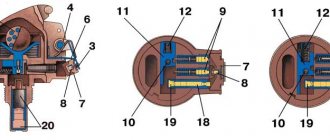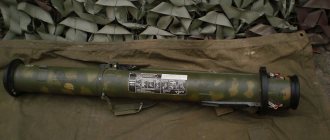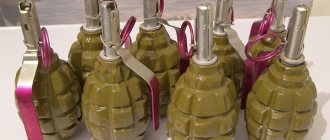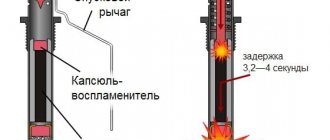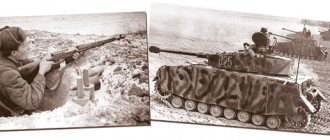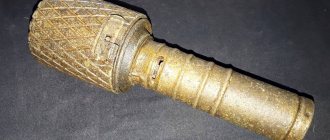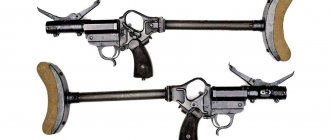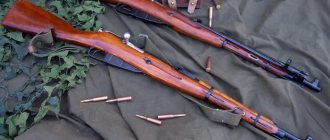Since the invention of armor by man, the question of confrontation between armor and projectile has arisen. The invention of the RPG made fundamental changes to the tactics of armored vehicles and, in general, also significantly affected the conduct of military operations. Let’s take a closer look at the relatively new RPG-30 grenade launcher, which has successfully passed a series of state combat inspections and received the name “Hook.”
The RPG-30 rocket-propelled anti-tank grenade launcher is a single-use weapon of 105 mm caliber. Designed to counter modern main battle tanks equipped with various means of protection - both active and dynamic. It was adopted by the Russian army at the end of 2012; the developer of the “Hook” was the NPO Basalt enterprise.
Small arms, ammunition, devices and accessories of the 19th-21st centuries
The site is a private collection of materials on the topic “firearms and ammunition” and is an amateur information and educational weapons portal. All information was obtained from open sources. The administration does not claim authorship of the materials used - all rights belong to their owners. The administration is not responsible for the use of information, facts or opinions posted on the site.
- Account Registration
- Weapon
- home
- Rules
The Russian Federation will show technologies for protecting information systems from hackers at an exhibition in Thailand
At the international event Defense & Security 2022, tools and solutions will be presented, “which have already been extensively tested and implemented in many infrastructure facilities in Russia”
Russia will take part in the international exhibition Defense & Security 2022, opening on Monday, where it will present its developments in the field of cybersecurity of national critical information systems, as well as domestically produced military products. The Russian special arms exporter, the Rosoboronexport company (part of Rostec), is participating in the exhibition, which will hold a presentation on the topic “Cybersecurity: information protection” as part of the exhibition.
Video RPG-28 Klyukva
https://youtube.com/watch?v=vWBCGUYF20I
The RPG-28 was first presented to the general public in 2007. The starting device is a monoblock pipe made of fiberglass. The trigger device is covered at the ends with rubber caps that can be destroyed when fired. To bring it into the firing position, the safety pin is removed, and the sighting devices are brought into the firing position, while the firing mechanism is cocked, and the grenade can be launched by pressing the trigger lever. If it is necessary to transfer the grenade back to the stowed position, the trigger mechanism is removed from the combat cocking when lowering the rear sight of the sight to a horizontal position and fixing it with a pin.
Due to the significant mass of the grenade assembly, a shoulder rest, a folding support leg behind it, and a folding front handle are located on the launch tube below. When fired, a dangerous zone is formed behind the launcher with a depth of up to 30 meters and an angle of 90 degrees.
The RPG-28 has tandem cumulative ammunition, which provides penetration of armor over 900 mm thick behind dynamic protection. The target firing range is 300 meters.
The RPG-28 rocket-propelled anti-tank grenade is a rocket with a tandem cumulative armor-piercing warhead: the main warhead, the warhead-leader, designed to overcome dynamic protection and a powder jet engine, which is fully exhausted in the barrel of a disposable starting device. Stabilization of the grenade along the trajectory is carried out using folding stabilizers and the axial rotation they impart to the grenade.
The RPG-28 was adopted by the Russian army in 2007. The size and weight characteristics of the grenade launcher allowed it to be used by one soldier in all conditions of modern combat. The RPG-28 rocket-propelled grenade ensured reliable destruction of existing and future tanks, including those equipped with mounted and built-in dynamic protection. For its unique qualities - reliability, power, excellent accuracy and unsurpassed penetration, the RPG-28 among specialists received the name “tank killer”.
Extent of damage caused
A shot from an RPG-30 grenade launcher, according to experts, is capable of penetrating:
- 650 mm of even the most modern armor, having overcome dynamic protection;
- about 1.5 m of reinforced concrete structures - barriers;
- more than 2 m of brick barriers;
- about 4 m of wood-earth barriers.
Having set themselves the main task of creating a weapon with which the armed forces of the Russian Federation can resist any enemy and any modern technology, the developers of NPO Basalt achieved their goal. It is impossible to escape from such weapons or resist them - the grenade launcher hits all types of armored and unarmored vehicles, protected fortifications and, of course, manpower.
In 2009, after state inspection and approval of the RPG-30, the Russian army purchased 1,000 copies at an approximate price of 83,000 rubles. a piece. For comparison, this is 2.5 times more expensive than the RPG-26 and RPG-22 grenade launchers, which were in service with the army at that time. Suppliers argue that the simulator is quite an expensive pleasure. And the waste of money, in fact, is completely justified.
Main structural and combat characteristics:
- caliber – 105 mm;
- weight – 10.5 kg;
- length – 1135 mm;
- shot range – 200 m;
- sight range – 200 m;
- thickness of barriers to be pierced: armor - 600 mm, reinforced concrete - 1500 mm, brick - 2000 mm, earth - 3700 mm;
- grenade launch speed – 120 m/s;
- caliber of the main grenade is 105 mm.
Video: RPG-30 review
History of creation
Since the middle of the last century, it has become obvious that existing grenade launchers are not capable of effectively fighting heavy armored vehicles. The following areas for improvement were noted:
- increased armor penetration;
- weight reduction for use by paratroopers.
The army leadership instructed GSKB-47 to create a new weapon capable of effectively destroying tanks. Designers V.I. Silin and A.T. Alekseev were selected. A number of requirements were put forward, based on which the development was carried out:
- Weight no more than 30 kilograms;
- Penetrate at least 300mm armor plate;
- Maximum unpretentiousness in combat conditions.
The project was designated "Spear" and the first prototypes entered testing in 1962.
SPG-9D in field assembled condition
The designers were never able to achieve the declared mass of the anti-tank gun. After discussion, we managed to agree to increase the permissible weight to 50 kilograms.
Features of disposable rocket launchers
The characteristics of such weapons as the RPG-22 determine the peculiarities of the technological process during its production. In order to fire a shot from the Netto, a short instruction is sufficient, since the weapon is delivered to the troops completely ready to fire. It is this feature that has led to the fact that such disposable complexes are very fond of various militants and terrorists in different parts of the globe.
The RPG-22 grenade has enough power to hit even some tanks with “active” armor, and there’s no need to even talk about various armored personnel carriers and infantry fighting vehicles. History has proven that although disposable grenade launchers have long been outdated, in the same US war with Iraq, the RPG-22 grenade quite often disabled Abrams-type tanks.
It is precisely because of the enormous combat effectiveness combined with low price that disposable rocket-propelled grenade launchers quickly replaced reusable grenade launchers from the leading position in the global market for weapons of this type.
Firing delays and ways to eliminate them
A grenade launcher, with proper care and conservation, and careful handling, is a reliable and trouble-free weapon. However, as a result of careless handling of the grenade launcher, contamination and wear of parts, as well as a malfunction of the grenade, there may be delays in firing
If there is a delay when firing, re-cock the hammer and continue shooting. If the delay repeats, reload the grenade launcher and continue firing. If recharging does not eliminate the delay, find out and eliminate the cause of the delay as indicated below.
| Delay | Reasons for delay | Remedies |
| 1. Misfire (no shot) | 1. The shot into the grenade launcher barrel was not fully fired. 2. Malfunction of the grenade igniter primer. 3. Wear or breakage of the striker. 4. Low impact of the firing pin on the igniter primer due to contamination or hardening of the lubricant of the trigger and firing pin mechanisms | Send the shot until the lock stops at the bottom of the cutout on the muzzle of the grenade launcher barrel. Replace the grenade. Change. Clean the trigger and firing mechanism. |
| 2. The shot does not enter the grenade launcher barrel | The barrel is dirty (remnants of a cardboard cartridge case, powder residue) | Clean the barrel |
Notes
- ↑ 1 2 3 4 5 (GNPP) “Basalt”.
[www.arms-expo.ru/site.xp/049051124053050053053.html RPG-30 is capable of hitting targets with an active zordoodle] (Russian). WEAPONS OF RUSSIA, Federal electronic directory of weapons and military equipment. — Press release of the RPG-30 grenade launcher from the manufacturer. Retrieved May 13, 2009. [www.webcitation.org/66KkhPJM1 Archived from the original on March 21, 2012]. - [army.lv/ru/rpg-30/1465/499 RPG-30 - rocket-propelled anti-tank grenade]
- [www.arms-expo.ru/049051124053050053053.html RPG-30 is capable of hitting targets with active protection - WEAPONS OF RUSSIA, Catalog of weapons, military and special equipment]
- [spec-naz.org/articles/oruzhie_i_boevaya_tekhnika/rpg_30_kryuk/ RPG-30 “Hook”]
- [www.popmech.ru/article/4753-kinzhal-protiv-tanka/ Dagger against the tank: New RPG-30] (Russian). Popular Mechanics magazine (14.01.09). Retrieved February 6, 2010. [www.webcitation.org/66KknupzE Archived from the original on March 21, 2012].
- ↑ 1 2 David Hambling.
[www.wired.com/dangerroom/2008/11/russia-unveils/ Russia Unveils 'Abrams Killer' Rocket] (Russian) (November 28, 2008). Retrieved February 6, 2010. [www.webcitation.org/66KksaDjV Archived from the original on March 21, 2012]. - Sean Rayment
.
[www.telegraph.co.uk/news/main.jhtml?xml=/news/2007/05/13/nmod13.xml MoD kept failure of best tank quiet], ' Sunday Telegraph'
(May 12, 2007 *). - Andrey Garvsky.
[www.redstar.ru/2006/08/30_08/5_02.html Thanks for the advertisement, or what is Merkava afraid of] (Russian). newspaper "Red Star" (August 30, 2006). — Assessment of Israeli statements about the losses of Merkava tanks from RPG-29 fire. Retrieved May 6, 2009. - [izvestia.ru/news/549448 The Russian army will receive a double-barreled grenade launcher "Hook" - Izvestia]
The principle of firing a grenade launcher
To load the projectile, the nozzle is tilted to the left, and the charge is added manually. When the shutter is closed, the contacts of the electrical circuit built into the unit are closed. The gunner cocks the trigger using the handle provided for this purpose. He is also waiting for a command to press the trigger that drives the generator. It delivers an electrically triggered discharge in the breech. The grenade igniter ignites the starting charge and the ammunition is pushed out of the barrel. The diaphragm remains in the barrel.
Memo on the ammunition
The grenade begins to rotate as it moves along the barrel due to the holes in the tail. This increases accuracy, since rotation stabilizes the projectile.
As the ammunition accelerates down the barrel, the pressure of the powder gases increases. When the limit values are reached, the disk located in the tail section remaining in the barrel is destroyed. Due to this, excess pressure is released through the nozzle, recoil is minimized.
After leaving the barrel, the blades on the tail of the grenade open. This happens due to centrifugal force and pressure of the oncoming air flow. The main engine starts 15-20 meters from the grenade launcher.
The crew may not have to wait for the flight to complete, as is required for guided missiles. You can immediately open the bolt after firing and load a new grenade. The part remaining from the previous projectile is ejected automatically when the bolt is opened.
Modifications
Work on modernizing the system practically did not stop, which gave rise to several modifications.
It also made it possible to create a weapon so successful that it is still used by the army to this day. Taking into account the experience gained when creating an infantry grenade launcher, the designers later developed a smoothbore gun for the first infantry fighting vehicles and infantry fighting vehicles. "Spear" represents the 2nd generation of domestic grenade launcher systems.
SPG-9D
This version has been modified to meet the needs of paratroopers. The main difference is the wheels on the frame.
SPG-9D
SPG-9M
An updated version in which the sighting device was replaced. The sight consisted of two articulated segments: the first allowed direct fire, the second allowed the use of weighted fragmentation ammunition. The machine was equipped with a telescopic “leg” at the front.
SPG-9M
PGN-9
A sighting device for combat at night. Passive infrared sight, designed specifically for use on the SPG-9.
In addition to these modifications, models with the abbreviation are known:
- DN;
- MN.
Both options differ from the basic ones (D, M) by the presence of a sight for night combat.
Night sight for SPG-9
